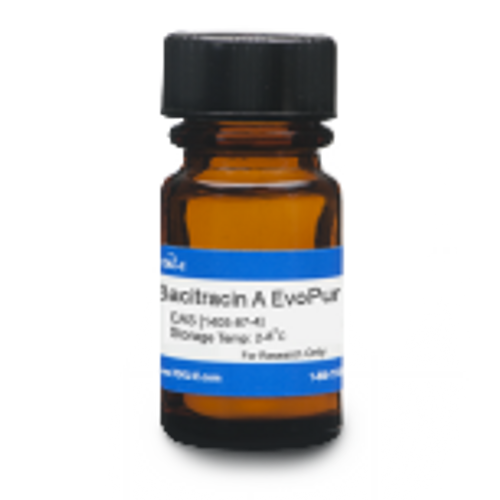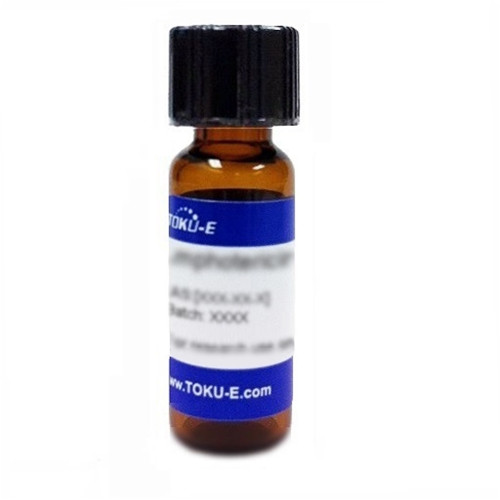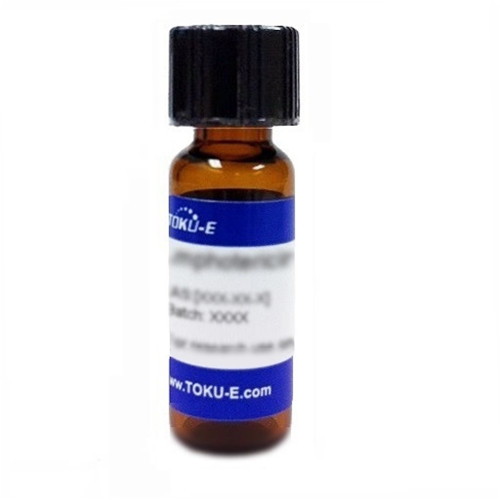Bacitracin A, EvoPure is a highly purified form of Bacitracin A. Bacitracin A is the most active and potent Bacitracin fraction. Our Bacitracins are bioactive, non-toxic congeners that are nontoxic to eukaryotic cell lines. Bacitracin A can also be used as an analytical reference standard.
Bacitracin is a polypeptide antibiotic, composed of related cyclic peptides made by Bacillus licheniformis first isolated in 1945 from the 'Tracy I' variety (ATCC 10716). It was isolated by Balbina Johnson, a bacteriologist at Columbia University. Bacitracin can be synthesized via nonribosomal peptide synthetases (NRPSs). The three-enzyme operon is called BacABC.
For more Bacitracin products, click here.
| Mechanism of Action | Bacitracin prevents phosphorylation of bactoprenol, a transport protein which carries peptidoglycan components outside the cell membrane. Without the active phosphorylated bactoprenol, peptidoglycan synthesis cannot be completed and the cell lyses. Resistance to Bacitracin is understood to involve two mechanisms: A protein transporter (BcrABC) which pumps bacitracin out of the cell after it has entered, and via another protein (BacA) which provides the active phosphorylated bactoprenol from a different synthetic pathway. |
| Spectrum | Bacitracin is narrow-spectrum and primarily targets Gram-positive bacteria including Streptococcus pyogenes and Staphylococcus aureus. |
| Microbiology Applications |
Bacitracin is a useful tool to differentiate between ß-hemolytic, group A Streptococci (Streptococcus pyogenes) and ß-hemolytic Streptocococci of other groups. Bacitracin can be used as a supplement in chocolate agar to facilitate the isolation of Haemophilus influenzae. Bacitracin can be used to study the regulatory network in B. subtilis. By systematically analyzing the Bacitracin stimulon, authors can pinpoint the loci induced by Bacitracin (Mascher et al 2003). The presence of Bacitracin can be determined by ultra-performance liquid tandem mass spectrometry, a novel method to extract and purity Bacitracin formulations in animal feed. Detection of Bacitracin A, B1, B2 and B3 was accomplished using Bacitracin products from TOKU-E (Feng at al, 2024). |
| Plant Biology Applications | Tobacco hairy roots and cell suspensions were used in plant transformation studies to produce full length murine IgG1 monoclonal antibody. Bacitracin has been shown to prevent degradation of peptides and hormones in plant systems. Treatment with Bacitracin was not sufficient to prevent loss of antibody from the cultures, but improved the growth rates by up to 53% (Sharp and Doran, 1999). |
| Eukaryotic Cell Culture Applications | Bacitracin can be used for gene selection in cell culture. TOKU-E researchers assessed the Selectivity Factor for the different grades of Bacitracin, and found that the SF range was 41- 350 for CulturePure grade versus 2-126 for USP grade, for the cell lines tested (HEK293, NIH/3T3, 293T, CHO-k1, B16). Bacitracin, CulturePure was used to inhibit antithymocyte globulin (ATG)-mediated tissue factor (TF) activation and surface-associated, protein disulfide isomerase (PDI) activity in HL60 cells. (Langer et al, 2013). Bacitracin, CulturePure was used as a PDI inhibitor to study its role in TF activation in cisplatin-treated NSCLC cells (Jacobsen et al, 2015). |
| Molecular Formula |
C66H103N17O16S |
| References |
Bell, RG (1992) Preparative high-performance liquid chromatographic separation and isolation of Bacitracin components and their relationship to microbiological activity. J. Chromatog. 590:163-68 Feng X, Jiayong Y and Yinliang W (2024) Optimal conditions for determination of Bacitracin, bacitracin zinc and bacitracin methylene disalicylate in animal feed by ultra-performance liquid tandem mass spectrometry. J. Chromatog B Vol 1243 (124234) |








